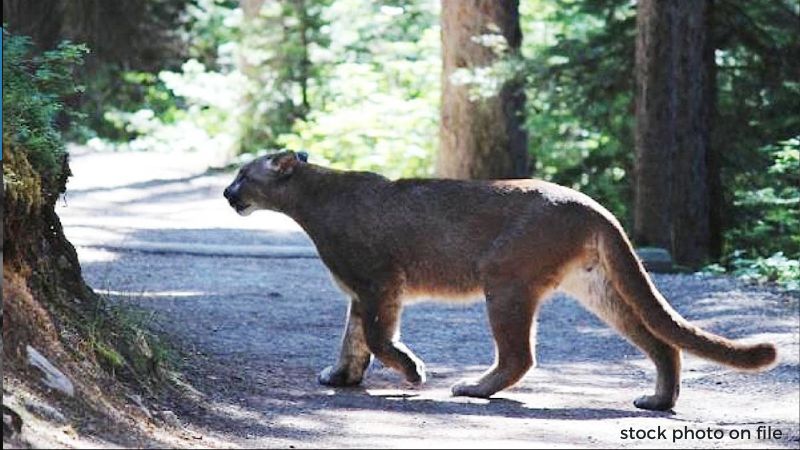Recent cougar sightings are an opportunity to learn how to coexist with wildlife and reduce human conflicts
This past week we captured a unique sight on the Mossom Creek wildlife cameras: four cougars moving through the protected Mossom Creek watershed. While this is a rare sight to capture on video, we know from experts that it is not unusual for female cougars and their offspring to stay together up to two years. We’ve caught this behaviour on camera two previous times over the past decade.
We want the community to be aware of this video for a few reasons:
- Cougars tend to stay hidden from sight and don’t make themselves known to people. There are only a handful of sightings reported in the Tri-Cities each year. We consider that seeing wildlife, especially apex predators move through the watershed, is an indication of a healthy ecosystem.
- We live in a wild place. Port Moody, Anmore, Belcarra and North Coquitlam border on hundreds of kilometers of wilderness. Cougars are big animals with large territories. A male cougar’s range may be 300 sq. km. while a female’s range tends to be about half of that. These cougars are most likely moving through the area because they are following preferred prey, most probably black-tailed deer.
- Cougars are intelligent animals and will move to where there are easy food sources. We want to remind the public that the onus is on each of us to prevent wildlife conflicts. Please read up on how to prevent cougars from visiting your yard.
In 2021, four cougars were destroyed in the Tri-Cities because they had become habituated to human food sources and grown too comfortable near homes. We want to prevent this from happening again by encouraging everyone to learn how to coexist with wildlife and prevent human-wildlife conflicts.
To this end, we are appealing to the public to remove attractants from their yards, keep their cats inside, not leave their dogs unattended in their yards, and keep pets leashed on trails. In addition to this request, we have included tips for how to prevent attracting cougars to your yard and information from a cougar presentation we hosted in 2021 below.
Prevent cougars from visiting your property
- Never feed any kind of wildlife. Feeding or leaving fallen bird seed or salt licks that attract wildlife such as deer to your property will, in turn, attract cougars and other predators.
- Avoid attracting small animals to your yard. Keep your garbage in a container with a tightly fitting lid.
- Keep the perimeter around your house clear of thick or tall vegetation. This will help ensure that cougars, other predators, and prey species will not see your home as a safe place to stop to rest or search for food.
- Close off open spaces under decks or patios with durable wire mesh. This will prevent wildlife, from using that space for shelter.
- Install motion-activated security lights. These may help frighten away curious cougars, bears, and other wildlife.
- Encourage your family and neighbours to take the same preventative measures on their property. If a cougar returns to your neighbourhood, it is because it has learned that food or shelter can be easily attained there.
- Cougars see domestic cats and dogs as easy prey.
- Keep your cats indoors.
- Dogs that stay outside unsupervised should be kept in a secure kennel that is covered across the top.
When walking in nature
- Walk in pairs or larger groups and be aware of your surroundings. Cougars don’t want to be around people, so make enough noise to prevent surprising a cougar.
- Keep dogs on leashes and be aware of your surroundings
co-existing with North America’s biggest cat
In 2021, BCIT Fish and Wildlife Program Instructor and wildlife conflict expert Tom Saare, joined us for a fascinating talk about the Lower Mainland’s most intriguing wild cat, the cougar. As urban growth touches our north shore wilderness areas and people venture into the local forests, we increase our contact with local wildlife. Cougar sightings and camera captures appear to be on the rise, but how much do we know about these big cats?
This presentation shares cougar biology and behaviours while discussing the most current thinking about how cougars live and adapt to their surroundings.
BOOK TITLES:
The Cougar: Beautiful, Wild and Dangerous
Paula Wild (published 2013)
The Cougar Conundrum: Sharing the World with a Successful Predator
Mark Elbroch (published 2020)
Carnivores of British Columbia (Royal BC Museum Handbook)
David Hatler, David Nagorsen, Alison Beal (published 2008)
CLIPS FROM PRESENTATION
AGENCY DOCUMENTS
- Procedure Manual: Preventing and Responding to Conflicts with Large Carnivores
- Conservation Officer Service: Human-Cougar Conflict Response Guidelines
- Predator Conflicts and Statistics
- Wildlife Alert Reporting Program-WARP (WildSafe BC)



